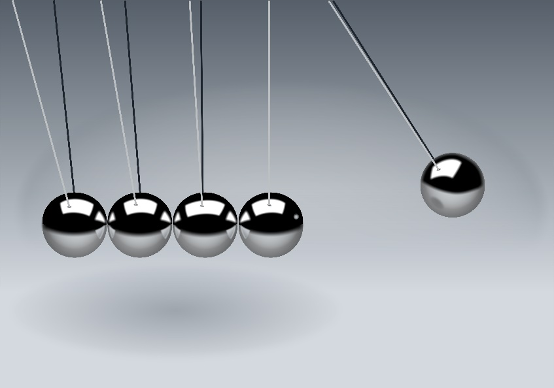
Ask a layman about the chance of a fair coin landing heads on a given coin toss, and the chances are (pun not intended) she or he will say 50%. That is the established line of thinking in academia as well and is known as the “propensity” interpretation of probability.

How probability was born
The story as to how this field of mathematics was born goes back to a French gambler named Chevalier De Mere in 1654. He proposed this particular problem to the mathematicians’ Pascal and Fermat of dividing a stake between two players which was interrupted before it was closed. Both formalised the problem in a series of letters which is now known as Probability theory.
Thus, was born the idea of equal chances of the numbers 1 to 6 occurring in a fair six-sided die. Each number had an equal chance of 1/6 (0.166 or 16.67%) appearing in a throw of the die. This became the main instrument of understanding situations where we have incomplete information about a situation, but the result set is given.
Probability and its use in real-life situations
How does that play out in real life? Will it rain tomorrow or not? There is say (for example) a 70% chance it will rain tomorrow the weather analyst may say. How did she come to that conclusion? The Weather Bureau will look at patterns in weather historically as well as an understanding of current weather movements to come up with a statistical probability as such.
The probability number is then the total number of scenarios where it could rain divided by the total number of scenarios possible. This may look like out of the 10 possible weather scenarios that could happen on a given day, 7 will consist of rain. Thus, we come up with the 7 divided by 10 (70%) chance.

For a deep learning neural network in vision detection, that probability will be the chance the algorithm has correctly detected a horse in a given picture. The algorithm may say 90% chance the picture is of a horse rather than say a statue of a man on a horse.

In the oil and gas industry where I worked for 8 years, I would often run elaborate monte carlo simulations to calculate the chance of success (cos) of an oil and gas prospect. Geologists, I would notice, would often just overwrite the number and put their own number in “based on experience”.
If I calculate something to be 60%, a geologist might scrub that off and put it like 30% instead. This first got me thinking the idea of probabilities may not be objective but based on subjective experience.
Probability as a figment of our imagination
Coming back to our coin toss, by convention we would say the chance of heads appearing on a given coin toss is 1 divided by 2 or 50%. We assume that for a fair coin, each of these possibilities is equal. There are two possible options – heads and tails, and heads happen to be one of them. Therefore 1 divided by 2 is 50%.
This is where our story to understand reality begins. Well, it appears not quite. Persi Diaconis and colleagues at Stanford built a mechanical coin tosser as part of the paper named “Dynamical Bias in the coin toss”.
Here they concluded that “We conclude that coin tossing is “physics” not “random.”
It turns out you can flip a coin on heads over and over again. 100% of the time. How? Using a calibrated mechanical coin tosser. I am attaching a picture from the experimental setup below: –

This would squarely suggest that the only reason coin tossing “seems” random is because there are so many variables we don’t control in real life from the shaking of the hand while tossing, to the velocity of the flip to how the coin lands are that it “seems” random to us.
In other words, randomness is simply a label our minds provide to cope with the incomprehensible complexity of life. This idea in academia is called “Subjective randomness as statistical inference”.
The subjective vs the objective interpretation of probability
What is less understood or considered is what does that probability number mean? Is it a facet of reality, or is it something of a guess – a figment of our imagination to make up for the fact that we only always have a limited amount of information about the world we live in?
While there are many interpretations of probability and scientists have been considering these ideas for ages, the interpretations largely fall into two buckets: –
- A subjective interpretation
- An objective interpretation
The objective interpretation says effectively that probabilities result from mechanisms that exist in the real world and not dependent on human judgment. It is the nature of a coin flip that it yields a 50% probability for each trial, or the 1/6th chance of any side on a fair 6 sided die.
The subjective interpretation meanwhile says that probabilities exist simply in our head because we possibly cannot know everything there is to know about the world and therefore, we make up such probabilities to navigate the world and make decisions.
You can think of almost any situation in life and this would apply to. We never fully know whether a given drug will work in a clinical trial, whether we find oil when we drill for it, whether the roads will be congested tomorrow in peak traffic, whether essentially there will be a “black swan event” tomorrow which you can’t predict.
The Covid-19 crisis would be one such crisis not many people would have predicted at the start of 2020 would take global proportions.

The idea itself was made famous by Thomas Bayes who came up with the Bayes’ formula which is ubiquitous in business and science.
Philosophic determinism
This is a problem I have been thinking about since taking my first class in probability during my A-Levels and I consider this to be one of the greatest problems of science, the key to understanding the nature of reality and advancing AI in the next decade.
The mechanical coin tosser as I see it squarely proves the subjective interpretation of probability beyond doubt and confirms Einstein’s famous statement “God does not play dice”. This is in a long rich history of scientists espousing the idea of philosophic determinism from Newton all the way back to Aristotle.
What does that really mean for business and the sciences? For a start, it radically redefines the template of what is possible and confirms the place of scientific enquiry in the modern world. If the probability is not innate to the world, then any randomness is a result of “hidden variables” we cannot resolve in a given situation.
The famous AI Scientist Judea Pearl writes so in his famous book “Probabilistic Reasoning in Intelligent Systems“ in Chapter 7:
“There is, of course, a whole spectrum of conditions we can draw from physics that would make the outcome of the coin sway in favour of either heads or tails. For example, we can specify a narrow range of initial conditions (e.g., position, orientation, and linear and rotational momentum) under which the outcome of the coin toss is almost sure. Such conditions do not qualify as meaningful contingencies, however, because short of complex scientific experimentation, the granularity and vocabulary required to specify these conditions lie beyond the level of abstraction common to everyday discourse.”
The theoretically possible in light of the subjective interpretation
Is it possible to cure cancer completely? Yes. The reason we can’t yet is that we haven’t resolved X number of variables about the human body, or chemicals and their reactions to the body yet. However, it is theoretically possible to build a computer simulation of the whole human body and the reaction a particular drug will have on it.
Is it possible to colonize Mars? Yes. We will have to control X more variables from temperature to light to weather however theoretically it is possible.
Is it possible to build Artificial General Intelligence on par with humans? Yes. Again, there are things we don’t know of yet but given we can resolve that detail, we should be able to.
Is it possible to predict the future perfectly? Yes. If we knew everything from the beginning of time till now, then theoretically it is possible to build a model to predict what will happen tomorrow to the stock price, to global warming, plastic in the oceans, where we will solve our energy needs from, how we will feed the rising population and how do we resolve the air pollution.
Can we solve the riddle of quantum mechanics? Yes, and the “hidden variable models” may point towards the truth more than an inherently probabilistic theory of quantum physics would.
Conclusion
Artificial Intelligence holds the promise to rapidly accelerate the answer to all of these questions and by seeing probability as not a part of reality but a mere figment of our imagination, it is possible to get to the theoretical 100%. After all, isn’t science just the way we keep finding new hidden variables in reality? As Einstein famously said, “God does not play dice”.



